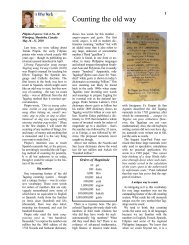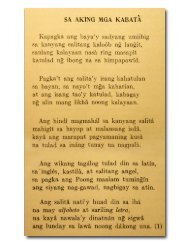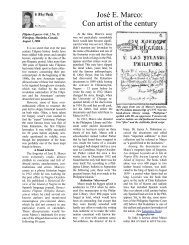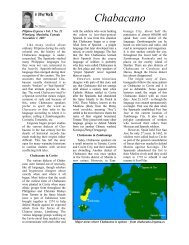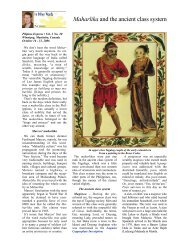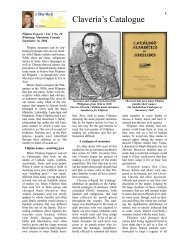Da Bathala Code copy - Pilipino Express
Da Bathala Code copy - Pilipino Express
Da Bathala Code copy - Pilipino Express
Create successful ePaper yourself
Turn your PDF publications into a flip-book with our unique Google optimized e-Paper software.
<strong>Da</strong> <strong>Bathala</strong> <strong>Code</strong> • Part 3 • Paul Morrow<br />
Santos, who was a highly respected writer and author of the<br />
first official grammar of the national language. Santos<br />
speculated on the word uha (cry of a newborn baby) as the basis<br />
for the shapes of the letters U (u), h (ha) and A (a). However,<br />
neither Tolentino nor Santos could claim to have discovered the<br />
<strong>Bathala</strong> <strong>Code</strong>. They merely embellished the ideas of another<br />
pseudo-ethnographer from a generation before them – Pedro<br />
Paterno.<br />
Pedro Paterno<br />
Fifty years before Tolentino wrote his Ang Wika at Baybaying<br />
Tagalog, Pedro Paterno wrote La antigua civilización tagalog in<br />
1887, 15 followed by several other books on Filipino ethnology.<br />
These were hardly a small influence on Tolentino’s far-fetched<br />
theories; they were probably some of his main inspirations, if<br />
not his virtual blueprint. Like Tolentino, Paterno tried to<br />
legitimize some really outrageous claims with questionable<br />
scholarship and outright fabrications, as we’ll see, but more<br />
than that, he himself played a prominent role during a crucial<br />
period of Philippine history. He is a fascinating character who<br />
deserves much more scrutiny than is possible in this series of<br />
articles. For more information about the infamous political<br />
career of Pedro Paterno, I recommend the book Brains of the<br />
Nation 16 by Resil Mojares.<br />
Inventing a religion<br />
Although Paterno was the originator of the <strong>Bathala</strong>-baybayin<br />
notion, it was not the main focus of La antigua civilización<br />
tagalog. Like many Filipino writers of his time, his aim was to<br />
show that Filipinos were capable of taking part in the<br />
governing of their own country under Spanish rule. But unlike<br />
the other Propagandists, as they were called, Paterno was a<br />
13



